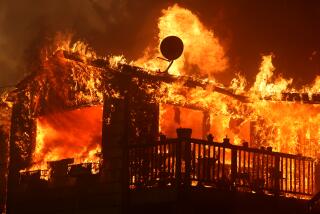Raging Fires Put Spotlight on Drought
MIAMI — Wildfires raged in at least eight states, from California to Florida, on Monday, a red-hot reminder that up to a quarter of the U.S. is gripped by drought.
“Hot and dry, and that’s the way it’s going to stay for the foreseeable future,” said Pat O’Bannon, a U.S. Forestry Service official on loan from his Northern California region to help fight fires that raced through woodlands in five Florida counties.
Flames were also eating up bone-dry forest lands Monday in Southern California, east of Hemet, and in Arizona, New Mexico and South Carolina, according to the Web site of the National Weather Service. The fires all fall within the broad swath of the U.S. identified by the service as in the throes of severe to extreme drought.
Three 20-person “hot shot” crews of firefighters from Northern California were sent to battle fires that broke out overnight near Flagstaff, Ariz.
“To date we’ve had about 1 million acres burned in 40,000 fires,” said Doug LeComte of the National Weather Service. “That is 30% more than last year. And the drought is to persist.”
Indeed, the uncontrollable wildfires that consumed more than 47,000 acres and about 200 homes in and around Los Alamos, N.M., earlier this month may signal just the beginning of a long, blazing-hot summer.
In the first drought forecast ever issued by the weather service, meteorologists in the spring predicted that severe to extreme drought would persist in southern Arizona, Texas, Louisiana, Mississippi, Arkansas, Alabama, Tennessee, Florida, Georgia, Nebraska, Iowa, Illinois and Indiana.
Drought conditions also are forecast to continue in the leeward areas of Hawaii.
A dry winter also has Southern California officials concerned that an outbreak of summer wildfires could surpass last year’s near-record season. Orange County officials have already declared nearly 180,000 acres of open land off-limits to hikers and other visitors.
Blame for the unusual lack of rainfall over parts of the U.S. during the last two years is assigned chiefly to La Nina, a weather phenomenon related to cooler-than-normal temperatures in the eastern and central Pacific Ocean. The good news: La Nina’s effects are weakening, forecasters say.
But above-normal temperatures, which speed up evaporation of rainfall and soil moisture, are predicted to continue, according to analysts, meaning they expect little relief on the near horizon.
In Arizona, where the period from October 1999 to April was the second driest on record, firefighters battled blazes in Kaibab National Forest, northeast of Flagstaff.
In New Mexico, only the monsoon rains that normally arrive in July are expected to permanently douse fires that continue to plague the state, where almost 300,000 acres have been scorched since the start of the year. Fires raged Monday in Cerro Grande and in the Cibola National Forest.
Other Memorial Day wildfires were reported near St. George, Utah; Weston, Colo.; and Glasgow, Mont.
Record droughts also are being reported in Louisiana and Georgia, where rainfall totals are as much as 29 inches below normal for the year.
In the Midwest, farmers report good-looking crops of corn and soybeans but are concerned that dry subsoil, soaring temperatures and forecasts of scant rain spell trouble later in the year.
In Florida, firefighters took control of a blaze that drove dozens of residents from their homes Sunday near Osteen, a town between Orlando and Daytona Beach. Another blaze near North Port, near Sarasota, was also reported contained.
Still, fires continued to roar through fields of pine and palmetto palms in Volusia, Orange, Osceola and Brevard counties, and the forecast was not good.
“Statewide, we’re in for another bad fire day as far as weather goes,” said O’Bannon. “The humidity is below 35%, and winds are 15 mph or higher.”
Planes and helicopters were called out Monday afternoon to drop tons of water on new blazes that erupted near Waldo, northeast of Gainesville.
O’Bannon said aerial surveys of central Florida indicate that lake waters are low and that depressions normally containing some water have dried up. “Very little standing water means there are fewer helicopter dip sites,” said O’Bannon, referring to spots where airborne firefighters can scoop up water to dump on flames. “It is drier than just about anybody can recall.”
Many of the areas most in danger now are those blackened by raging fires in July 1998, when more than 500,000 acres were burned and the towns of Bunnell and parts of Daytona Beach were ordered evacuated for days.
“Conditions are going to require us to be very vigilant on fire lines to contain these fires,” said O’Bannon. “And our resources are stretched, so any new starts could be critical.
“We’re drier now than last year, and that makes the hair stand up on our necks a little bit. But there is a silver lining. With no rain there are no lightning strikes.”
More to Read
Sign up for Essential California
The most important California stories and recommendations in your inbox every morning.
You may occasionally receive promotional content from the Los Angeles Times.










